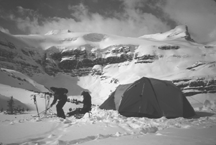

by Tim Martin

CAMPING? This time of year? In the snow?
For most of us, the mere thought of cold-weather camping brings on such classic rebuffs as, "You must be out of your mind," and other adages involving turnip trucks and hayseeds.
But for Kate and John Monahan and their 5-year-old daughter, Emily, there is a unique loveliness in the hills and woods when snow is on the ground. It's a great way to enjoy the beauty and solitude of nature.
The Monahans, of Arcata, discovered the sport by accident last November when a storm dumped five inches of powder on their favorite camping spot in the Trinity Alps Wilderness Area.
"It snowed the night before we got there," John Monahan said. "We were comfortable during the day. The temperature was around 45 degrees. But at night the temperature dropped down into the 20s."
But that didn't mean the Monahans were flattening themselves in a storm-battered alpine tent or huddling around a Svea stove for warmth. They came fully prepared for bad weather.
"In summer you can get by with lightweight equipment," John said. "But in the winter you need to carry a ground cloth, a good tent with a rain fly and a well-insulated sleeping bag."
According to Monahan, a high-quality sleeping bag is a must for cold-weather camping. In temperatures down to 20 degrees Fahrenheit, a sleeping bag rated to five degrees will suffice. When camping in zero degree and below temperatures, you should have a bag rated to minus 30 degrees.
Good equipment is essential to cold-weather survival, but good sense is even more important. Nature is not forgiving of foolish mistakes in the winter. One common problem is hypothermia, a subnormal body temperature that causes disorientation, confusion and drowsiness.
"The best way to fight hypothermia is to stay dry and eat plenty of hot food," explained Monahan. "I carry a backpacker's stove and food that can be cooked quickly, like pasta. I also bring lots of hot chocolate -- It's good for a sugar rush."
If snow camping sounds dangerous or daredevilish, it's not. The Monahans, like most winter campers, are not Patagonia-clad apostles out to get their faces rubbed in Mother Nature's leg hairs. If anything, they strive to be as comfortable as possible.
"To keep warm we cooked a hot meal and built a campfire," said John. "And we kept a close eye on Emily. When you snow camp with kids it's a good idea to watch them closely. They tend to romp a lot and get chilled. And they won't say anything until their lips are blue.
"When we camp with Emily, we try to bring a friend along for her to play with. It's also a good idea to bring some kind of entertainment along, like books or games or artwork. The sun goes down early in the winter."
Sean Thobaben, of Arcata, has seen his share of early sunsets in the frigid alpine settings. He is an experienced ski mountaineer who over the last four years has hiked and camped on Mount Shasta, Crater Lake and in the Cascades. He recently spent a month on the ice fields of the Canadian Rockies.
"When you're camping at an elevation of 8,000 feet, you've got to dress warm," said Thobaben. "You need high-quality waterproof clothing, a down jacket, pile garments and good boots."
Thobaben, 27, wears double plastic mountaineering boots and insulated gators on his excursions into the Rockies. He packs a staggering 70 pounds worth of food, rope and climbing gear.
The load is reduced substantially when he bivouacs in a snow cave.
"If I'm staying in one place for several days, I'll dig a snow cave," Thobaben said. "But when I'm traveling, I use a tent. I prefer a snow cave, but they take three to four hours to build. That's hard to do after you've been hiking all day."
Thobaben believes that a well-built snow cave is much warmer than a tent. More importantly, it provides better protection against the wind.
In the Rockies, where temperatures drop to minus 20 degrees at night, a snow cave can be a life saver. Twenty degrees below zero is cold enough with no air movement, but a strong wind can freeze exposed flesh in an instant.
Thobaben says he has only been in danger once during his numerous mountaineering expeditions. He was climbing in a remote area of the Rockies with two other mountaineers when a storm blew in.
"We were ski traversing across ice fields and climbing the surrounding peaks when a storm hit," Thobaben explained. "We had two days worth of supplies left and it was a two-day hike out, most of it across moving glaciers and big crevasses. In zero visibility that's like signing your own death warrant. The storm didn't let up and we waited until the last minute to leave. Luckily, we made it out safely.
"Winter camping is a very viable thing to do," he added. "Just always make sure you know what you're getting into."
For more information about snow camping and wilderness survival, contact Center Activities at Humboldt State University, or Sierra Wilderness Seminars, in Arcata.